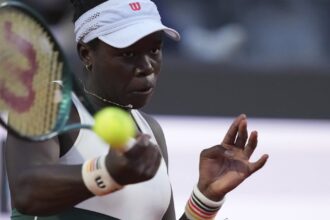The electric atmosphere at Montreal’s IGA Stadium yesterday evening told a tale of two trajectories as Italy’s Lorenzo Musetti powered through to the third round of the National Bank Open while Canadian hopeful Talia Arseneault saw her tournament dreams fade under the summer lights.
Musetti, the 23-year-old Italian whose fluid backhand has become something of a tennis spectacle, dispatched France’s Arthur Fils in a commanding 6-4, 7-5 victory that showcased why he’s becoming one of the tour’s most watchable talents. The match featured the kind of shot-making that pulls spectators from their seats—a beautiful counterpoint to the more power-driven game that dominates much of modern tennis.
“There’s a certain renaissance happening in Italian tennis,” I remarked to a colleague as we watched Musetti’s elegant game unfold. With Jannik Sinner’s recent Grand Slam breakthrough and Musetti’s continued development, we’re witnessing what tennis historians might later identify as a golden period for the nation once primarily known for its clay court specialists.
The Montreal crowd, always appreciative of technical brilliance regardless of nationality, responded to Musetti’s performance with the kind of enthusiasm that makes the National Bank Open one of North America’s most respected tennis showcases. Yet their hearts clearly belonged to Arseneault, the 21-year-old from Quebec who carried local hopes into her evening match against Spain’s Paula Badosa.
Arseneault’s tournament journey ended with a 6-3, 6-2 defeat that, while decisive on the scoreboard, featured moments of brilliance that suggest Canada’s tennis pipeline remains impressively productive. The developmental arc from Bouchard to Andreescu to Fernandez and now to prospects like Arseneault speaks to Tennis Canada’s systematic approach to talent cultivation—a model other nations increasingly seek to emulate.
“What’s remarkable about Canadian tennis development isn’t just the technical instruction,” noted former Davis Cup captain Martin Laurendeau in a pre-tournament conversation. “It’s the mental preparation for the rigors of the tour. These young players understand the psychological demands of the sport in ways previous generations simply didn’t.”
The National Bank Open, formerly known as the Rogers Cup, continues to serve as a crucial barometer for players heading toward the US Open. As a Masters 1000 event, it draws a field that mirrors Grand Slam quality while offering a uniquely Canadian tennis experience. The tournament’s alternating locations between Montreal and Toronto create distinct atmospheres that players often comment on—Montreal bringing European-style passionate engagement, Toronto offering a more cosmopolitan energy.
Tournament director Eugène Lapierre has built upon this foundation, creating what many players now consider one of the tour’s most player-friendly environments. “The National Bank Open understands something fundamental about tennis in the modern era,” said Lapierre during the tournament’s opening ceremony. “It’s not just about matches—it’s about creating moments that resonate beyond the scoreline.”
As Musetti advances deeper into the draw, he’ll face increasingly stringent tests against a field that includes several of the sport’s most formidable talents. Meanwhile, Arseneault will absorb the lessons from this appearance, adding them to the experiential knowledge that shapes a player’s evolution.
The beauty of tennis lies partly in its unforgiving transparency—there’s nowhere to hide on court, no teammates to mask shortcomings. This sporting honesty creates narratives of remarkable clarity. Today, those narratives moved Musetti forward while temporarily pausing Arseneault’s progression on this particular stage. Tomorrow brings new chapters, new possibilities, and the continued unfolding of tennis stories that captivate us precisely because they reflect life’s broader competitive truths.
Will Musetti’s artistic approach find success against the sport’s power merchants in the later rounds? And how will Arseneault translate this experience into future growth? These questions linger as the National Bank Open continues its compelling 2025 edition.
For more analysis on emerging talents and tournament developments, visit our CO24 Culture and CO24 Trends sections, where we’ll continue tracking the stories that define not just this tournament, but tennis’s evolving landscape.










